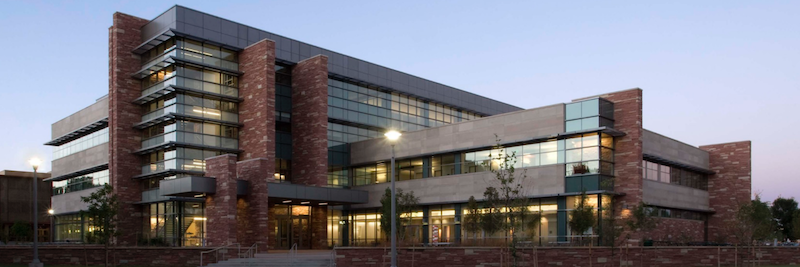Growth-minded AEC firm CannonDesign announced this morning that it will merge with Denver-based Bennett Wagner Grody Architects (BWG), a 28-year AE firm with portfolio strengths in the K-12, Higher Education, and healthcare sectors.
This alliance gives CannonDesign its first office in Colorado, and represents its second acquisition within the past few months. In September, Cannon announced that it was joining forces with Houston-based design firm FKP, whose expertise extends to healthcare, science and technology.
CannonDesign did not disclose the terms of its agreement with BWG. But Brad Lukanic, AIA, who took over as CannonDesign’s CEO 15 months ago, indicated that this deal is part of his 102-year-old company’s larger ambitions to expand by linking with strategic partners. “We’re in the mode of looking at how our practice is evolving,” he tells BD+C. “The two recent mergers are key steps” in CannonDesign’s growth framework, and are expected to help the company expand its position in the education and S+T sectors.

Brad Lukanic, CannonDesign's CEO, says his company intends to continue growing organically and through mergers with strategic partners. Image: courtesy of CannonDesign
Don Grody, AIA, a founding partner at BWG, says that about a year ago his firm started thinking about its future within a consolidating AE industry, too. It concluded that prosperity hinged on locating the right partner firm. He says the company worked up a list of 200 AE firms, and targeted 20 of them with an information piece about BWG. “CannonDesign was one of the firms that responded positively to BWG as well as to the Colorado market.”
Grody says the merger “allows us to harness new services and expertise to help our clients leverage the built environment to improve performance and create stronger futures. It gives us a very distinct perspective in the industry.”
CannonDesign has coveted a bigger presence in Denver “for a very long time,” says Lukanic. BWG’s recent projects in the state include Colorado State University’s Behavioral Sciences Building, Colorado Mesa University’s Engineering Building, and numerous projects with Kaiser Permanente. CannonDesign’s work in Colorado includes the renovation and expansion of the University of Colorado at Boulder’s Student Recreation Center, the expansion of the University of Colorado Hospital’s Anschutz Inpatient Pavilion, and the U.S. Air Force Academy’s Holaday Athletic Center.

Don Grody, one of BWG's founding principals, is in charge of innovation, quality planing, and excellence at his firm. Image: courtesy of CannonDesign
BWG’s management team, including its three principals, is staying on with the company. BWG will operate as Bennett Wagner Grody Architects | CannonDesign, and while its brand will eventually disappear, that transition process “could be fairly long,” predicts Lukanic, because Cannon Design doesn’t want to lose any of BWG’s marketing cachet.
Once its merger with BWG is completed, CannonDesign will have nearly 1,000 employees working in 19 offices in North America and abroad.
As for future expansion, Lukanic says CannonDesign is tracking markets where populations are growing and where its core business sectors are strong. He points specifically to Texas as an area where the firm wants to be a bigger player, and to construction services as an area for potential increased business.
He says that CannonDesign is also looking at “a few key international markets” for expansion, both within and outside of North America.
Lukanic believes that, by operating multiple offices, CannonDesign has a better shot at attracting and retaining the “emerging leaders” it will need to be successful in the future. Its geographic diversity “gives our people more lifestyle options.”
Related Stories
Apartments | Jun 27, 2023
Dallas high-rise multifamily tower is first in state to receive WELL Gold certification
HALL Arts Residences, 28-story luxury residential high-rise in the Dallas Arts District, recently became the first high-rise multifamily tower in Texas to receive WELL Gold Certification, a designation issued by the International WELL Building Institute. The HKS-designed condominium tower was designed with numerous wellness details.
University Buildings | Jun 26, 2023
Addition by subtraction: The value of open space on higher education campuses
Creating a meaningful academic and student life experience on university and college campuses does not always mean adding a new building. A new or resurrected campus quad, recreational fields, gardens, and other greenspaces can tie a campus together, writes Sean Rosebrugh, AIA, LEED AP, HMC Architects' Higher Education Practice Leader.
Standards | Jun 26, 2023
New Wi-Fi standard boosts indoor navigation, tracking accuracy in buildings
The recently released Wi-Fi standard, IEEE 802.11az enables more refined and accurate indoor location capabilities. As technology manufacturers incorporate the new standard in various devices, it will enable buildings, including malls, arenas, and stadiums, to provide new wayfinding and tracking features.
Green | Jun 26, 2023
Federal government will spend $30 million on novel green building technologies
The U.S. General Services Administration (GSA), and the U.S. Department of Energy (DOE) will invest $30 million from the Inflation Reduction Act to increase the sustainability of federal buildings by testing novel technologies. The vehicle for that effort, the Green Proving Ground (GPG) program, will invest in American-made technologies to help increase federal electric vehicle supply equipment, protect air quality, reduce climate pollution, and enhance building performance.
Office Buildings | Jun 26, 2023
Electric vehicle chargers are top priority for corporate office renters
Businesses that rent office space view electric vehicle (EV) charging stations as a top priority. More than 40% of companies in the Americas and EMEA (Europe, the Middle East and Africa) are looking to include EV charging stations in future leases, according to JLL’s 2023 Responsible Real Estate study.
Laboratories | Jun 23, 2023
A New Jersey development represents the state’s largest-ever investment in life sciences and medical education
In New Brunswick, N.J., a life sciences development that’s now underway aims to bring together academics and researchers to work, learn, and experiment under one roof. HELIX Health + Life Science Exchange is an innovation district under development on a four-acre downtown site. At $731 million, HELIX, which will be built in three phases, represents New Jersey’s largest-ever investment in life sciences and medical education, according to a press statement.
Sports and Recreational Facilities | Jun 22, 2023
NFL's Jacksonville Jaguars release conceptual designs for ‘stadium of the future’
Designed by HOK, the Stadium of the Future intends to meet the evolving needs of all stadium stakeholders—which include the Jaguars, the annual Florida-Georgia college football game, the TaxSlayer.com Gator Bowl, international sporting events, music festivals and tours, and the thousands of fans and guests who attend each event.
Industrial Facilities | Jun 20, 2023
A new study presses for measuring embodied carbon in industrial buildings
The embodied carbon (EC) intensity in core and shell industrial buildings in the U.S. averages 23.0 kilograms per sf, according to a recent analysis of 26 whole building life-cycle assessments. That means a 300,000-sf warehouse would emit 6,890 megatons of carbon over its lifespan, or the equivalent of the carbon emitted by 1,530 gas-powered cars driven for one year. Those sobering estimates come from a new benchmark study, “Embodied Carbon U.S. Industrial Real Estate.”
Virtual Reality | Jun 16, 2023
Can a VR-enabled AEC Firm transform building projects?
With the aid of virtual reality and 3D visualization technologies, designers, consultants, and their clients can envision a place as though the project were in a later stage.
Mechanical Systems | Jun 16, 2023
Cogeneration: An efficient, reliable, sustainable alternative to traditional power generation
Cogeneration is more efficient than traditional power generation, reduces carbon emissions, has high returns on the initial investment, improves reliability, and offers a platform for additional renewable resources and energy storage for a facility. But what is cogeneration? And is it suitable for all facilities?

















